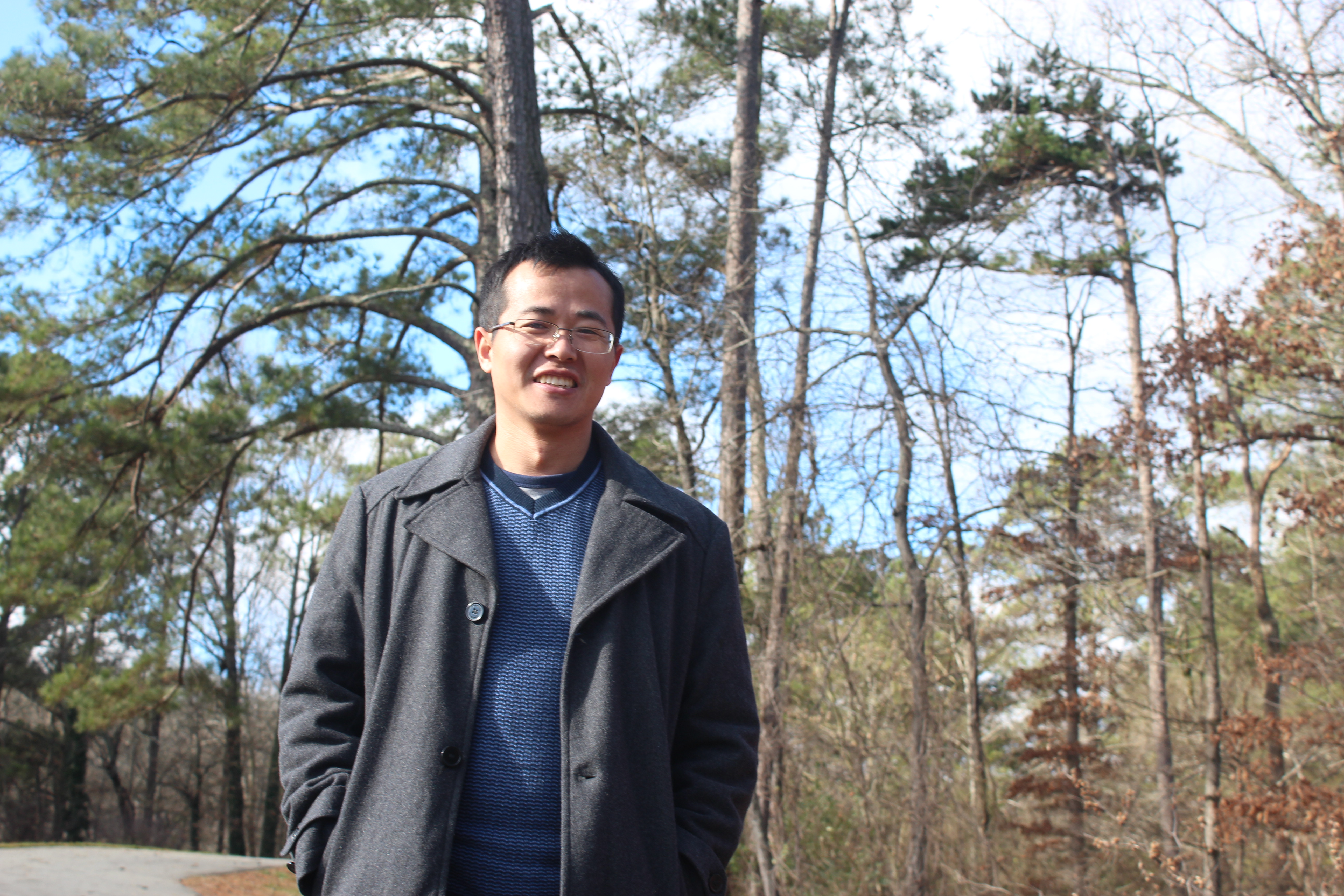
周宏钰
1981年11月,籍贯山东省济南市
博士,教授,研究院书记
广东省“ZJ人才计划”青年拔尖人才
广州大学大湾区环境研究院环境健康研究所
地址:广州大学城外环西路230号,510006
教育背景
2000.09 - 2004.06 山东大学化学与化学工程学院,应用化学,学士
2004.09 - 2009.06 山东大学药学院,药物化学,博士
工作经历
2009.09 - 2012.04 美国圣尤大儿童研究医院,博士后
2012.04- 2016.08 美国艾默里大学,博士后
2016.09- 2018.09 暨南大学环境学院,研究员
2018.10- 至今 广州大学大湾区环境研究院,教授
研究方向
基于人类细胞组合的污染物健康效应评价;基于PM2.5人工模型的大气颗粒物致毒机制研究;环境污染物生物效应的构效关系及预测模型
科研项目
1) 国家自然科学基金面上项目,22076033,基于肝脏类器官的纳米材料毒性效应及毒性机制研究,2021/01-2024/12,63万,进行中,主持;
2) 广州市校联合资助基础研究项目,202102010441,基于人体类器官的纳米材料毒性效应的高通量筛选平台的构建,2021/04-2023/03,20万,进行中,主持;
3) “ZJ人才计划”青年拔尖人才,2017GC010269,2018/01-2022/12,进行中,主持;
4) 广州大学”百人计划”科研启动项目,290020309,新型污染物的安全性评价及毒性机制研究,2018/9-2023/9,300万,进行中,主持;
5) 国家自然科学基金重大研究计划培育项目,91743107,细颗粒物多组分混合暴露的联合毒性机制研究,2018/01-2020/12,80万,已结题,主持:
6) 暨南大学培育与跃升计划,21617445,金纳米颗粒库的快速高通量构建及其生物效应,2017/01-2018/12,12万,已结题,主持;
7) 国家重点研发计划,2016YFA0203103,水污染治理所用纳米材料的生物安全性,2016/07-2021/06,890万,已结题,参加(2/14);
8) 国家自然科学基金重大研究计划培育项目,90913006,选择性治疗耐药性肺癌的噻唑烷酮类小分子探针的设计、合成及体外抗癌活性研究与机制探讨,2010/01-2012/12,50万,已结题,参加;
发表论文、专著、专利及奖励
代表性论文:
1) Cong Li, Xinxin Huang, Weicui Min, Huoqing Zhong, Xiliang Yan, Yan Gao, Jianqiao Wang, Hongyu Zhou*, Bing Yan*. Inflammatory response induced by synergistic actions between nanoplastics and typical heavy metal ions in human cells. Environmental Science – Nano. 2023, In press.
2) Yanxin Wu#, Rongtao Liu#, Jian Liu, Jianbo Jia, Hongyu Zhou*, Bing Yan. The role of crystallinity of palladium nanocrystals in ROS generation and cytotoxicity induction. Nanoscale. 2023, 15, 6295-6305.
3) Long Kong, Guizhen Yan, Xinxin Huang, Yanxin Wu, Xin Che, Jian Liu, Jianbo Jia, Hongyu Zhou*, Bing Yan. Sequential exposures of single walled carbon nanotubes and heavy metal ions to macrophages induce different cytotoxicity Sci. Total Environ. 2023, 864, 161059.
4) Jian Liu, Yuting Wen, Yucong Mo, Weizhen Liu, Xiliang Yan, Hongyu Zhou*, Bing Yan. Chemical Speciation Determines Combined Cytotoxicity: Examples of Biochar and Arsenic/Chromium. J. Hazard. Mater. 2023, 448, 130855.
5) Liu RT, Xu ZB, Zhao C, Zhang SY, Zhou HY*, Zhou L, Liu YD, Min YG*. Mediate neurite outgrowth of PC-12 cells using polypyrrole-assisted laser-induced graphene flexible composite electrodes combined with electrical stimulation. Eur. Polym. J. 2022, 181, 111634.
6) Liu J, Che X, Huang XX, Mo YC, Wen YT, Jia JB, Zhou HY*, Yan B*. The interaction between biochars from distinct pyrolysis temperatures and multiple pollutants determines their combined cytotoxicity. Chemosphere, 2022, 296, 133999.
7) Kong L, Wang XH*, Li XY, Liu J, Huang XX, Qin YJ, Che X, Zhou HY*, Martyniuk CJ, Yan B. Aggravated toxicity of copper sulfide nanoparticles via hypochlorite-induced nanoparticle dissolution. Environ. Sci. Nano 2022, 9, 1439-1452
8) Kong L, Wu YX, Li C, Liu J, Jia JB, Zhou HY*, Yan B*. Nano-cell and nano-pollutant interactions constitute key elements in nanoparticle-pollutant combined cytotoxicity. J. Hazard. Mater. 2021, 418, 126259.
9) Bagheri AR, Li CJ, Zhang XL, Zhou XX, Aramesh N, Zhou HY*, Jia JB*. Recent Advances in Covalent Organic Frameworks for Cancer Diagnosis and Therapy. Biomater. Sci. 2021, 9, 5745−5761 (Designated by Biomaterials Science as one of the most accessed papers in 2021)
10) Li C, Liu J, Wang DJ, Kong L, Wu YX, Zhou XX, Jia JB, Zhou HY*, Yan B*. Electrostatic attraction of cationic pollutants by microplastics reduces their joint cytotoxicity. Chemosphere 2021,282, 131121.
11) Jia JB*, Limongi T, Liu Y, Su GX, Zhou HY*. Nano-Bio Interactions: Ecotoxicology and Cytotoxicity of Nanomaterials. Front. Bioeng. Biotech. 2020, 9, 819
12) Gou Y, Miao DD, Zhou M, Wang LJ, Zhou HY*, Su GX*. Bio-Inspired Protein-based nanoformulations for Cancer Theranostics. Front. Pharmacol. 2018, 9, 421.
13) Sun HN, Liu Y, Bai X, Zhou XF, Zhou HY*, Liu SJ, Yan B*.Induction of oxidative stress and sensitization of cancer cells to paclitaxel by nanoparticles with different charge densities and hydrophobicities. J. Mater. Chem. B. 2018, 6, 1633--1639.
14) Sun HN, Yan GZ, Zhou HY*. Nanoparticle-Induced Oxidative Stress. Chapter in Yan B, Zhou HY, and Gardea-Torresdey J., eds. Bioactivity of Engineered nanoparticles, Springer Press, Inc. 2017, 63-79.
15) Liu Y, Su GX, Wang F, Jia JB, Li SH, Zhao LL, Shi YL, Cai YQ, Zhu H, Zhao B, Jiang GB, Zhou HY*, Yan B*. Elucidation of the Molecular Determinants for Optimal Perfluorooctanesulfonate Adsorption Using a Combinatorial Nanoparticle Library Approach, Environ. Sci. Technol. 2017, 51(12), 7120-7127.
16) Su GX#, Zhou XF#, Zhou HY*, Li Y, Zhang XR, Liu Y, Cao DP, Yan B.* Size-Dependent Facilitation of Cancer Cell Targeting by Proteins Adsorbed on Nanoparticles. ACS Appl. Mater. Interfaces 2016, 8, 30037–30047.
17) Zhou HY, Qian WP, Uckun F. M, Wang LY, Wang A. Y, Chen HY, Kooby D, Yu Q, Lipowska M, Staley C. A, Mao H, Yang L* IGF1 Receptor Targeted Theranostic Nanoparticles for Targeted and Image-guided Therapy of Pancreatic Cancer. ACS Nano, 2015, 9, 7976–7991.
18) Zhou HY, Su GX, Jiao PF, Yan B.* Accelerating multifunctionalization of theranostic nanoparticles using multicomponent reaction. Chem. Eur. J. 2012, 18, 5501-5505.
19) Zhou HY, Jiao PF, Yang L, Li X, Yan B.* Enhancing Cell Recognition by Scrutinizing Cell Surfaces with a Nanoparticle Array. J. Am. Chem. Soc. 2011, 133, 680–682.
20) Zhou HY, Mu QX, Gao NN, Liu AF, Xing YH, Gao SL, Zhang Q, Qu GB, Chen YY, Liu G, Zhang B, Yan B.* A Nano-Combinatorial Library Strategy for the Discovery of Nanotubes with Reduced Protein-Binding, Cytotoxicity, and Immune Response. Nano Lett. 2008, 8, 859-865.
奖励
◆ 闫兵,周宏钰,陈令新,江桂斌,典型纳米材料的生物效应及调控方法原理,山东省自然科学一等奖,2019,证书编号:ZR209-1-1-R02。
◆ 2018年获评“ZJ人才计划”青年拔尖人才。

